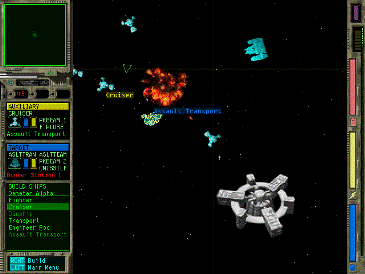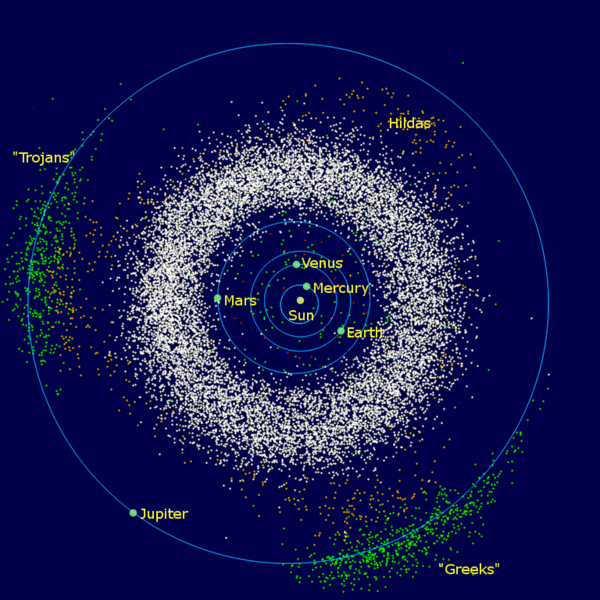Tactics, Systems, & Galaxy-Generators
Hatuli, and Ares
In EV: Override, there is a star system called "Hatuli" that has two planets, very far apart from each other, and a profitable trade route between the two. Pirates infest the system, attacking anyone who tries to trade between the planets. It keeps you constantly on your toes, keeping an eye on where the pirates are & what they're up to at any given point in time, either trying to slip past them or to take them head-on. It makes for a very interesting, tactical gameplay experience, derived entirely from how the system is laid out in-game.
Screenshot from Ares.
As a kid, I also extensively played & modded another 2D space game from Ambrosia, called Ares. It has similar mechanics to the EV series, but with a tactical focus. In Ares, almost every system has several key locations, such as planets, outpost stations, moons, etc. The tactical objective of the game varies from level to level, but it always involves utilizing the locations – sometimes capturing a resource generator to boost your ship production, sometimes retreating to an asteroid belt to hide, sometimes defending your own planets, etc. It leads to a rich variety of different types of engagements, depending on what is going on in the larger tactical picture at any given time.
Systems in Orion Skies
In Orion Skies, I am hoping to replicate that tactical-system experience. A key component of making that happen will be to have multiple locations of interest within each star system, as the norm. As I worked on this concept, I decided pretty quickly that I wanted to include stars as spobs in the systems, and to have the planets orbit them logically in various different configurations. By including anywhere from 0-3ish planets in each system, and using a combination of single, binary, and triple-star systems, I'd be laying the foundation for establishing, from a tactical point of view, myriad unique configurations of multiple key locations within each system.
Partial map of our Solar System.
The problem with this approach is that it greatly multiplies the number of spobs that need to be created, as well as the difficulty of placing them well – I know from my Ares mods that it's tricky to consistently position things around other objects in a way that looks good, without falling into patterns of arranging them the same way over and over.
Galaxy Generator
As I continued to think about the logistics of creating these systems for Orion Skies, I realized that it would actually be easier, better, and much quicker to create a tool to place the stars & planets for me, rather than doing it myself. So I opened up a new Google Sheet and started kicking some spreadsheet formulae around, seeing if I could get it to create these systems. Once that was working, I realized that it should be possible for the spreadsheet to also place the systems on the galactic map, add hyperlinks, determine the planets' climates based on how close to their stars they are, etc.
Galaxy Generator's "Settings" tab.
At some point I had the realization that this tool could be just as useful for other people as it would be for me, so I added a variety of settings so that its output could be configured for a variety of different plug-in concepts:
- Are you creating a "classic" EV-like galaxy?
- Are you creating a new galactic region to add to Override's galaxy for an expansion plug-in?
- Are you creating a scenario set in a ring galaxy, or with a quasar blocking travel to the center of your galaxy?
- Are you creating a scenario set within a specific sector of a galaxy?
And of course, Orion Skies is its own unusual case, a scenario set entirely within a nebula.
After several months of working on the Galaxy Generator, it is fully functional and ready for public use! It has already seen some use on an in-development multiplayer EV game currently titled "mpevmvp", and I hope other developers and plug-in authors continue to find it helpful in their work. :)
Image Gallery
These images are of actual content created by the Galaxy Generator.
Part 1 - System Previews
The images in this section were created within the Galaxy Generator's built-in "system preview" feature:
Part 2 - Galaxy Previews
These images were created within the Galaxy Generator's built-in "galaxy preview" feature. Jump-links are included in these galaxies, but do not show up in the previews:
Part 3 - Jump-Links
This screenshot, showing jump-links, was taken from within the in-development multiplayer EV game, mpevmvp, which uses multiple galaxies created by the Galaxy Generator:











Comments
Post a Comment